Training
How to Train Your Dog to Sit Using Positive Reinforcement
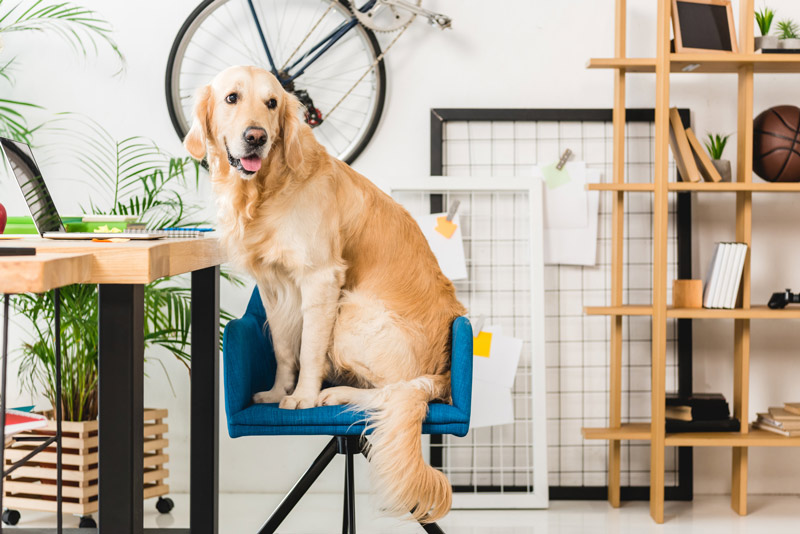
Teaching your dog to sit is one of the first commands taught in any basic obedience class.
It may seem silly at first, but the Sit command is an important one. It is useful in many situations, but foremost, it helps your dog settle down and focus his attention on you.
Table of Contents
Why Teach Your Dog to Sit?
The Sit command will come in handy in a number of situations.
- Having your dog wait for the light to change before crossing a street
- Preventing him from jumping all over a guest as soon as you open the door
- Helping you attach the leash before going for a walk
First, it helps to know what a proper “sit” looks like because given a chance, many dogs will try to cheat by hovering above the ground rather than actually sitting.
When a dog is in a classic sit, his bottom is touching the ground. Even better, his bottom is touching the ground, and he’s looking at you. Ultimately, you want your dog to stay in a sit until you give the “release” command, but that may take a little longer.
Bonding and Building Trust
Before you attempt to teach your dog to sit, you need to understand what not to do.
Training your dog is important not only for good manners and safety; it also strengthens your bond and sets the right tone. Bonding is not the same as loving your dog. Love comes naturally.
Bonding is at the core of the human-dog relationship. Bonding is trust. You can love your dog without being bonded, but that isn’t enough.
If you don’t have this bond, as soon as the front door opens, not only won’t your dog sit and focus on you, she will run out the door and keep running. If your relationship is based on trust, you will be able to do things your dog won’t like, such as giving medicine or brushing her teeth, and your dog will let you do it because she trusts you not to hurt her.
In order to strengthen your bond through training, you need to know what not to do.
What NOT to Do When Training Your Dog to Sit
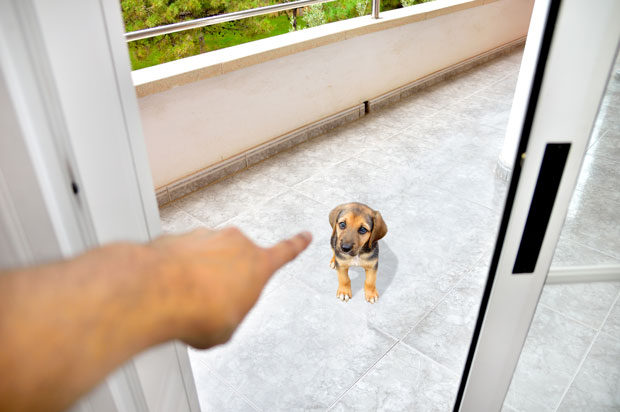
The following is a list of human behavior that is inconsistent — or even harmful — to the training process. These behaviors will make your dog afraid of you and possible invoke an aggressive reaction.
- Do not use punishment. If you train by punishment rather than reward, all you will achieve is a dog who is afraid of you — and doesn’t know the command Sit. Research has shown that confrontational techniques do not work; instead, they tend to create problems rather than solve them.
- Do not attempt to train your dog if you’re annoyed. You will only succeed in making your dog anxious, and she will perform poorly, which will make you even more annoyed. The idea is to make training fun.
- Don’t ever hit your dog. Don’t use a rolled-up newspaper, or your hand, or anything. Never intentionally cause your dog pain.
- Don’t yell at your dog. Dogs respond better to soft, high-pitched voices. All those people using baby talk on their dogs are on to something.
- Don’t try to aggressively stare down your dog. Your dog will respond with aggression or fear. Neither of these reactions is conducive to training.
- Don’t use the “Alpha Roll,” which is the physical act of forcing your dog onto her back or side and holding her there to assert your dominance. All it teaches your dog to do is not to trust you.
- Don’t pinch or grab her. The idea that it replicates what mother dogs do is beside the point. You’re not a dog or the dog’s mother.
- Don’t jerk on the leash as a “correction.” Your dog won’t understand what you’re saying. Again, it just teaches your dog not to trust you.
- Don’t try to assert your dominance. You become your dog’s pack leader because your dog trusts you, not because she fears you.
- Don’t forget that training is a repeat exercise. If you achieve teaching your dog to sit, don’t expect her to remember in six months if you haven’t practiced. Training should be an ongoing process, even when your dog has mastered her commands.
- Don’t try one method and give up if it doesn’t work. Dogs, like people, are individuals. What training technique works with one dog might not work with another. If the first technique isn’t working, try another one.
- Don’t be inconsistent. Let’s say you’ve taught your dog to sit before opening the door to a guest — except for your best friend. Maybe she doesn’t mind Fido jumping all over her. Maybe you’re so excited to see her, you forget to give the command. All this will do in the end is confuse your dog, and that will cause a loss of confidence.
If he is allowed to jump on one person but must sit for others, how will he know which person he can jump on and which person he should “sit” before greeting? If you are inconsistent, don’t get annoyed with your dog if he doesn’t follow your command.
- Don’t be impatient. Getting impatient when your dog doesn’t get it right away is counterproductive. This will only stress her out, and make the training process harder.
Maybe your dog is tired. Maybe she’s frustrated. Maybe the training session has just gone on too long.
Imagine if you were trying to learn how to play the saxophone. It’s a reed instrument, and it takes practice to produce a sound. Now imagine if your teacher was getting all hot and bothered because you’re just “not getting it.” What do you think would happen?
You’d probably give up the saxophone entirely. Don’t be impatient and give your dog a reason to hate training.
- Don’t expect your dog to read your mind. The only way to teach your dog anything is to tell her what you want in a way that she will understand. If your dog jumps around thinking you want to play when you want her to sit, it’s your fault — not your dog’s.
How to Train Your Dog to Sit
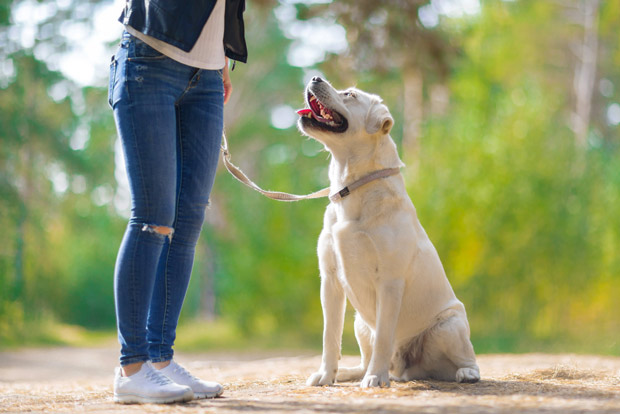
Training a dog is all about timing. If you want your dog to understand what you want, you have to know exactly when to give a treat and say “yes!” or press a clicker.
There are a few different ways to teach your dog the sit command. You may have to try more than one technique; your dog will let you know which one will work.
Technique #1: The Treat
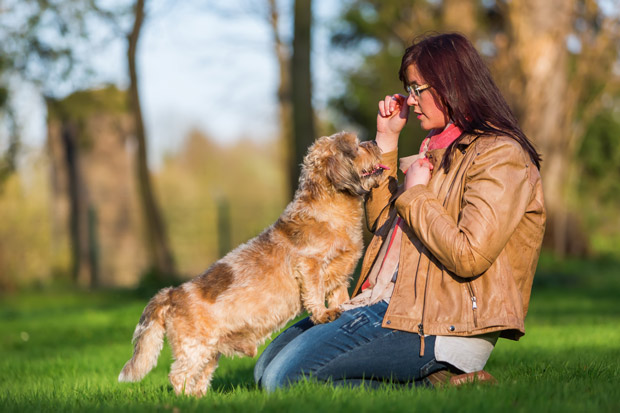
This technique is the one most used by dog trainers. It’s extremely effective, and you should try it first. This method can be used to teach your dog other basic commands too.
Use “high value” treats, meaning something out of the ordinary that your dog really, really wants. It can be very small pieces of steak or hamburger. Sliced turkey from the deli is a crowd pleaser or shredded pieces of roast chicken. If you use a dog treat, use one that you don’t normally give your dog. Be sure to break up your treats into tiny pieces; you don’t want to end up with an obese dog, even if he’s an obese dog who can sit.
The first step is to get your dog’s attention and keep it focused on you. Stand in front of your dog so he is facing you.
Show him the treat. Keep it in your hand in a way that he can’t get it, but he knows that it’s there.
Hold the treat in your closed fist very close to his nose, and then, keeping your hand close to or even touching his fur, slowly raise it over the top of his head and back until your fist rests on the back of his head. Make sure to hold the treat close enough to your dog’s head that he won’t be able to jump up to get it. His eyes and nose will follow the treat by looking up, which causes his bottom to hit the ground.
As soon as he sits, use a word of praise that you will stick with consistently, like “Good!” or “Yes!” and simultaneously give him the treat,
If your dog steps back, position your dog in a corner of the room, and then stand in front of him. This limits his ability to back up.
Don’t add any other words but the command and a word for praise. You want the Sit command to stand out. If he doesn’t sit, position him closer to you, and move the treat over his nose and up over to the back of his head until his bottom touches the ground.
Keep the tone of your voice soft. A loud tone may sound aggressive and will only scare your dog.
Release your dog from the sit by saying a word, like “okay,” while simultaneously taking a step back and encouraging him to follow you.
Repeat the exercise for no more than 10 minutes a session. Stop sooner if he gets bored or frustrated. The idea is to make the exercise fun, like a game with a yummy treat as reward.
When it’s clear he understands what you want when you say Sit, add in a hand signal. Extend the hand that doesn’t have the treat, and hold it palm up. As you say sit, raise your hand. Be sure that the hand signal happens simultaneously to giving the Sit command. Hand signals are useful if you’re in a noisy place, or you’re far away from your dog, or if your dog ever loses some hearing.
Try to do this exercise 2 or 3 times a day for a week or two until your dog sits consistently. Then train using the voice command alone and the hand signal without the verbal command. The goal is to have him respond equally to your voice and your signal.
When your dog consistently understands the command, intermittently substitute enthusiastic praise, and, depending on your dog, rub his head or scratch behind his ears or whatever rocks his boat. Work toward getting your dog to sit consistently without a treat. Eventually, he should sit with the verbal command alone, with the hand signal alone, or with both.
Technique #2: For the Active/Distracted Dog
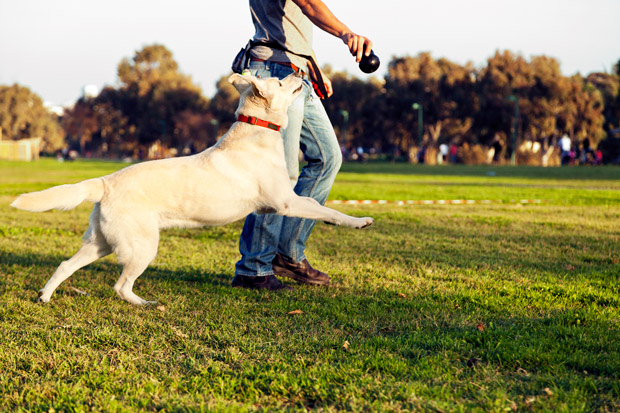
Some dogs have so much energy, it may be harder to get them to focus on you. For this technique, put your dog on a leash to keep him close to you. You want him to stay in front of you. A harness that has a leash attachment on the chest rather than the back may be easier.
Hold the leash to keep the dog close to you, but don’t make it so tight that he’s afraid or uncomfortable. Face your dog, walk backwards, and then stop. Most dogs will sit and look up at you. If he is frustrated or confused, walk around a little and guide him in front of you gently.
If he doesn’t sit naturally, try very gently pushing on his back directly above his rear legs. This touch should be for guidance only — DO NOT force him to sit. That is completely ineffective. As soon as his bottom touches the floor, say the command “sit” in a calm voice. Keep your hand on his back for a few seconds so he understands that this position means “sit.” Give him a treat while he’s in the Sit, and praise him.
Repeat, using your hand until he starts sitting with your voice command alone. If he is not getting it, or seems to be resisting, you can try moving to another location or to a different floor surface. You can also take a break and try again later, or give your dog some play time to work off extra energy.
Repeat this process. With a very energetic dog, it can take longer, but persistence is the key. Over time, you’ll figure out the best time to train. Try to find a time and place with the least distractions.
As soon as he sits consistently, move onto a sit without using your hand on his back. Still using the leash, say “sit,” and give him a treat as soon as he does. The idea is to work up to him sitting on command without a leash and without a treat every time.
Technique #3: Reward Natural Behavior
This technique is less effective with high energy dogs, puppies, or dogs who are easily distracted. It works best with a dog whose attention is often focused on you.
Pick a time and a place that’s quiet without a lot of distractions. Work in a small space, but let your dog roam freely. Your job is to observe your dog’s natural behavior.
Do not attempt to coax your dog into a sit, but wait until he sits on his own. As soon as his bottom hits the floor, say, “sit” and immediately give him a treat and praise. Keep your voice calm and friendly.
Repeat often. Pick a half-hour period when it’s quiet with the least distractions, and a place where you can physically stay close to your dog. It may take longer for him to associate the command with his action, so you should plan on training more often than the techniques above. As soon as he sits on his own, say the command, and treat and praise him.
Once it’s clear that he understands that the action relates to the command, work on getting him to sit when you ask him rather than waiting for him to sit on his own. Treat him every time he sits on command.
Proof the Behavior
For all of these techniques, you’ll need to “proof the behavior.”
This means training in different locations with different levels of noise and distraction. Proofing ensures that your dog will sit when you give the command, wherever you are.
Cesar's Rules: Your Way to Train a Well-Behaved Dog

For those dogs who just won’t seem to listen, whether it’s a new puppy or old dog in need of new tricks, this book is filled with practical advice, anecdotes, tips, and trouble-shooting techniques
Positive Reinforcement Only
This is worth repeating because these human mistakes can set a dog up for failure for the rest of his life.
You must associate all training with positive rewards.
Dogs do not react well to negative reinforcement such as yelling, yanking on the leash, or the worst offense of all, hitting. If you do not have the patience to be gentle and set your dog up for success, do not do the training yourself.
Setting your dog up for success means creating situations where your dog is most likely to succeed. It means making those successes a foundation for your dog’s self-confidence. Consider this: if your dog is having trouble learning to sit, the problem is a failure of communication — but it’s your failure. You have to be able to communicate with your dog in a way that he or she understands what you want.
With lots of love and patience, your dog will be sitting on command in no time at all.
- Topics:
- Training



